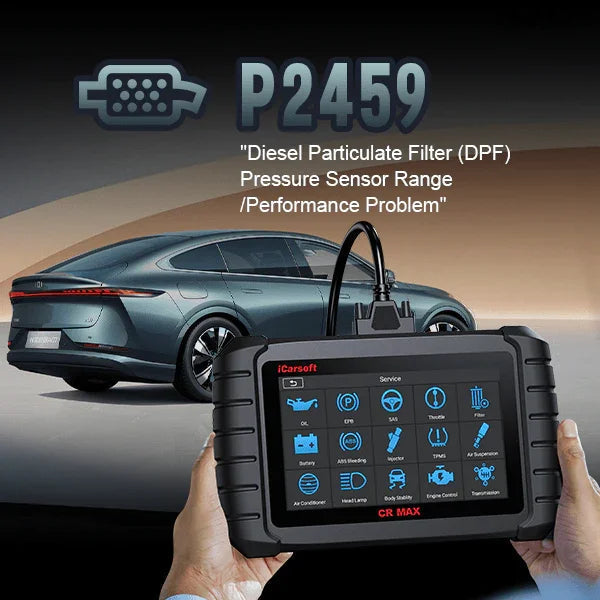<
Table of Contents
The P2459 OBD-II code indicates a diesel particulate filter (DPF) regeneration frequency issue. It’s commonly found in vehicles like VW TDI, Ford Powerstroke, and Audi Q7. This guide explains P2459 causes, symptoms, fixes, and prevention to help you avoid expensive repairs and maintain performance. For more model-specific guidance, see our Vauxhall P2459 regeneration troubleshooting guide.
1. What is P2459?
P2459 means the ECM (engine control module) detects that the DPF regenerates too frequently or irregularly. The DPF traps soot, and regeneration burns it off. If regeneration occurs every 50–80 miles instead of 200–300, this code appears.

2. Causes of P2459 OBD-II Code
Common causes of P2459 DPF regeneration frequency issues include:
- Faulty DPF Pressure Sensor: Incorrect readings mislead the ECM. Example: 2016 VW Passat TDI fixed by sensor replacement.
- Excessive Soot in DPF: Frequent short trips caused P2459 in a 2015 Ford F-250 Powerstroke.
- EGR Valve Clogs: Increased soot buildup in a 2017 Chevy Silverado Duramax.
- Exhaust Leaks: A 2014 Ram 2500 had P2459 due to a cracked exhaust manifold.
- Fuel Injector Issues: A 2018 BMW X5 35d required injector cleaning to resolve P2459.
- Driving Habits: A 2019 Audi Q7 TDI triggered the code from city-only driving.
3. Symptoms of P2459 in Diesel Vehicles
Signs your diesel vehicle may have a P2459 regeneration problem:
- Check engine light illuminated
- Reduced engine power or limp mode
- Poor fuel economy due to frequent regenerations
- Excessive exhaust temperature during regeneration
- More frequent active DPF regeneration cycles
4. Vehicles Prone to P2459 Code
P2459 is frequently reported in:
- VW Passat TDI (2012–2016) – bad pressure sensor
- Ford F-250 Powerstroke (2011–2017) – excessive soot buildup
- Chevrolet Silverado Duramax (2013–2018) – clogged EGR cooler
- Ram 2500 (2013–2019) – exhaust leaks
- BMW X5 35d (2014–2018) – faulty injectors
- Audi Q7 TDI (2015–2020) – frequent city-only trips

5. How to Diagnose P2459 OBD-II Code
- Scan with OBD-II tool for P2459 and related codes like P2463 (soot accumulation)
- Check DPF pressure sensor (0.5–4.5V output range)
- Monitor regeneration intervals (should be 200–300 miles)
- Inspect EGR valve and cooler for clogs
- Look for exhaust leaks before and after the DPF
- Review driving habits—short trips may block regeneration
6. How to Fix P2459
Fixes depend on diagnosis. Common solutions include:
- Replace DPF pressure sensor ($50–150)
- Perform manual or forced regeneration ($0–100)
- Clean or replace EGR valve/cooler ($100–300)
- Repair exhaust leaks ($50–200)
- Clean/service fuel injectors ($150–500)
- Take longer weekly highway drives (30+ minutes)
7. Preventive Measures for P2459
- Drive at highway speeds weekly for proper regeneration
- Use top-tier diesel fuel to reduce soot
- Service EGR system every 50k miles
- Check DPF sensors annually
- Maintain injectors for efficient combustion
8. FAQ: P2459 Diesel Troubleshooting
- Can I drive with code P2459? Yes, but ignoring it may cause limp mode or DPF damage.
- How much does it cost to fix P2459? Repairs range from $50 (sensor) to $500+ (injectors/DPF service).
- Will P2459 clear itself? No, it requires proper regeneration or repairs.
- Is P2459 dangerous? Not immediately, but it increases emissions and risks expensive DPF replacement.
- Does P2459 always mean a bad sensor? No, it could also be soot buildup, EGR, or exhaust leaks.
- How often should DPF regenerate? Normally every 200–300 miles. More frequent cycles may indicate an issue.
9. P2459 Diagnostic Summary
The P2459 OBD-II code indicates a DPF regeneration frequency problem caused by sensors, soot, EGR, or driving habits. Timely diagnosis and repair can prevent limp mode and expensive DPF replacement. For brand-specific cases, see our Vauxhall P2459 guide.












